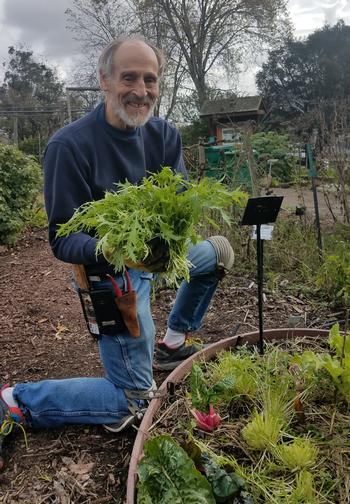Five Asian Vegetables to Try in Your Garden
by Birgitt Evans

Every year, in our Lake Merritt Trials Garden, the Master Gardeners grow a variety of herbs and vegetables to see how different varieties produce in our Oakland climate and soil. We then recommend the best varieties to the gardening public. In 2019, we wanted to explore food grown by the many Asian cultures represented in Alameda County. We grew a variety of uniquely Asian vegetables, many of them new to us, and found that several were real standouts. Here are five that we loved and think you will enjoy adding to your own gardens and tables.
Komatsuna or Spinach Mustard (Variety: Summer Fest) We had no experience with this easy-to-grow and very hardy vegetable. Planted directly from seed, vigorous plants produced a continuous harvest of crisp and spicy leaves from late spring through fall. Also, the plants did not falter in the summer heat. We planted it again this February and it survived seven weeks of neglect as we were locked out of the garden this spring and was waiting for us when we returned in May. The leaves are excellent in soups, stir-fries, and sauteed.
Loose Leaf Chinese Cabbage (Variety: Beka Santoh) Popular in Japan, we planted this pale green variety in the fall and it provided heavy harvests of frilly leaves right into January. It prefers a cooler growing season, so it is perfect for the fall and winter garden. Use in both cooked dishes and salads.
Mizuna Mustard (Variety: Mizuna Early): Originating near Kyoto, Japan, this mustard has long, narrow serrated leaves which can be added to salads for a spicy crunch or cooked. We planted them in fall and harvested a large crop well into winter, but the plants are also heat tolerant and grow well in the summer. For summer crops in hotter inland areas, provide some afternoon shade.
Thai Basil (Variety: Thai Red Stem): These medium-sized plants had deep green leaves with reddish stems. The leaves had a strong anise/clove flavor. The plants were easy to grow and produced an abundant harvest into early December. If you love Thai food and want to up your game during the pandemic, this is a great plant to grow. If you hurry, there is still time to get a crop in for fall.
Lemongrass: Popular in Thai, Vietnamese, Cambodian, Indonesian, and other Asian cuisines, lemongrass is an easy-to-grow perennial grass that forms clumps. You can sometimes find plants in nurseries or do what we did and root your own from purchased lemongrass. Select stalks whose base has not been cut too short, cut back the tops of the leaves by one-third, and place them in a glass of water in a bright shade. Change the water every few days and look for root growth. Pot them up when roots form, keeping the plants in light shade until established. Once new stalks form, harvest the outer stalks by peeling them gently away from the plant at the base. Lemongrass is not frost tolerant, so in colder areas, grow them in a pot and bring them inside during the winter. Use in curry paste, stir-fries, soups, marinades, and cosmetics.

